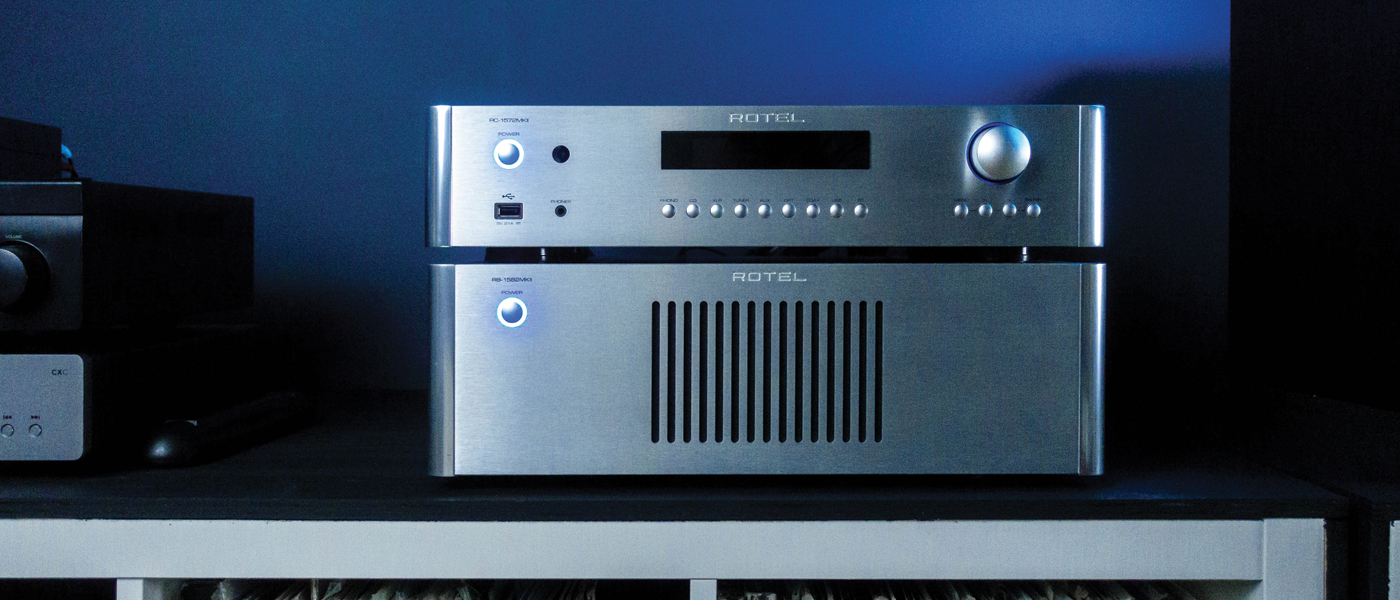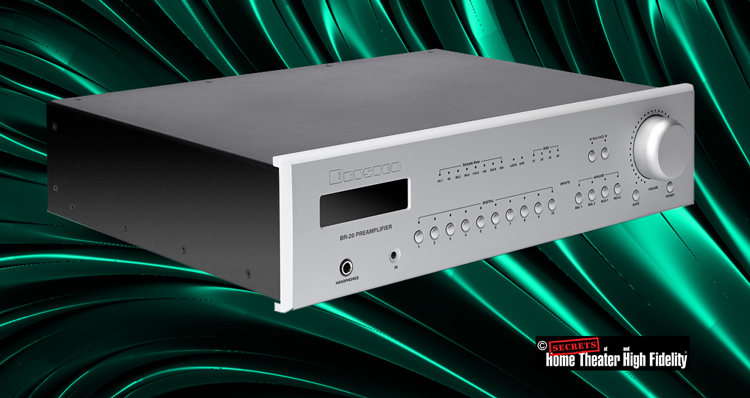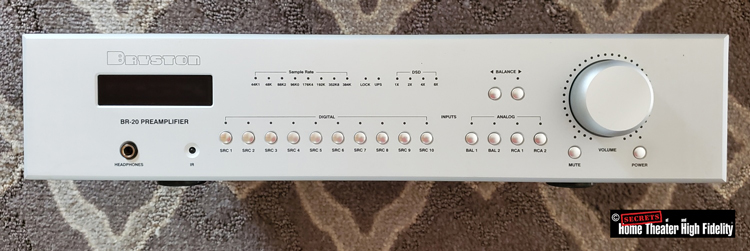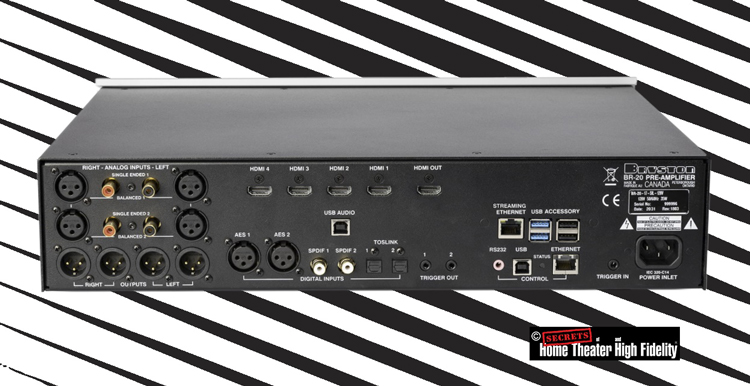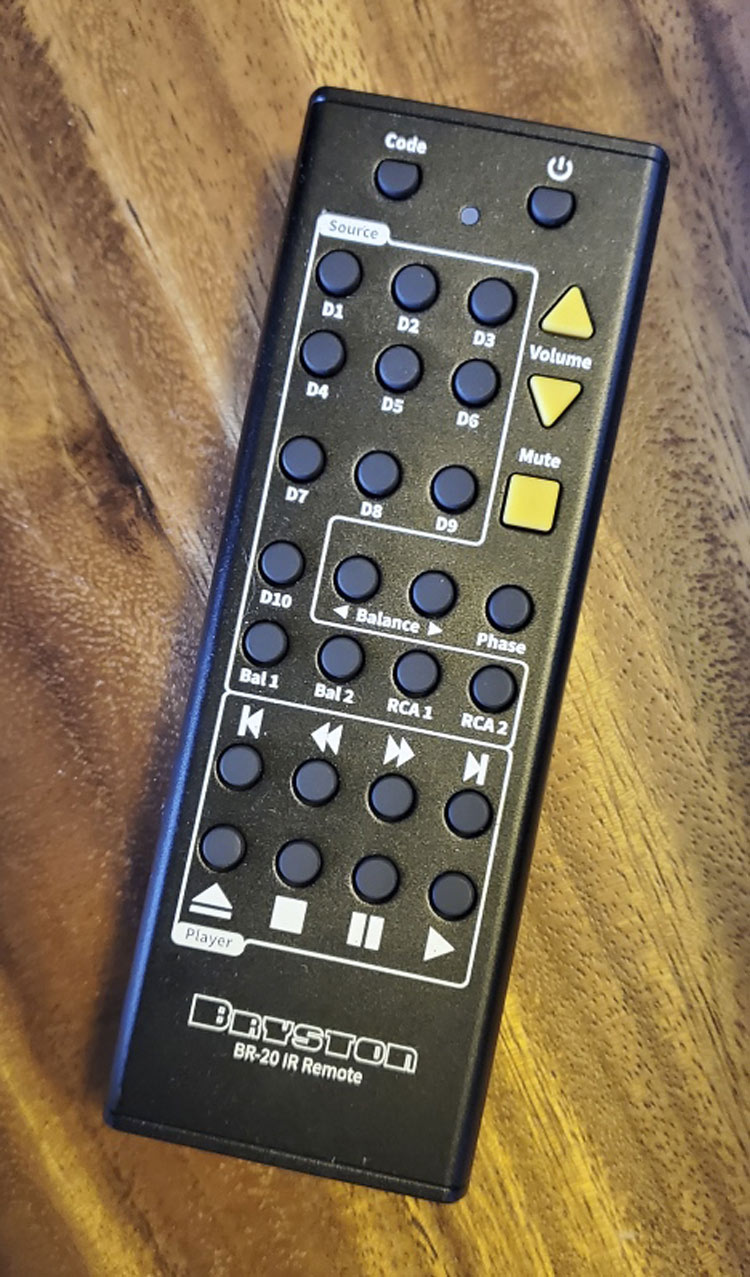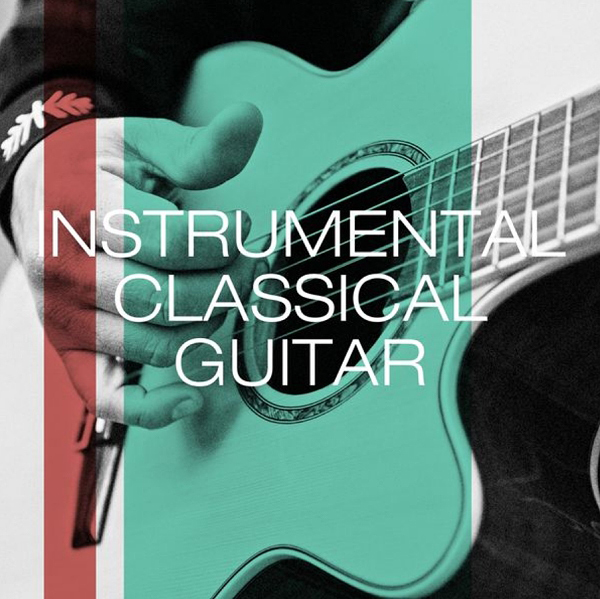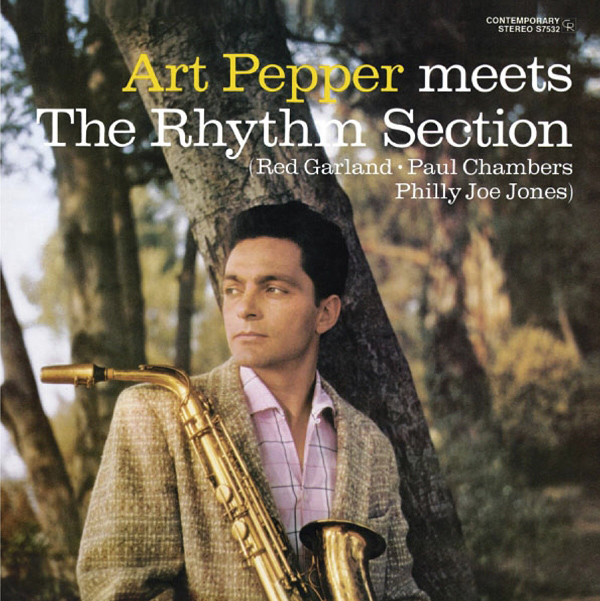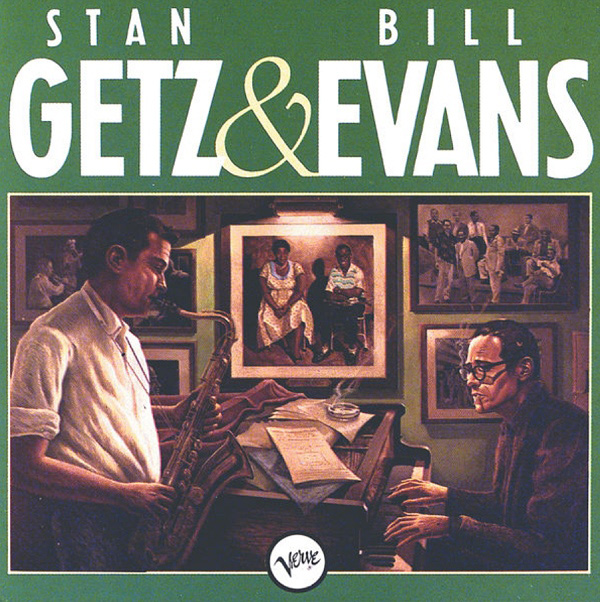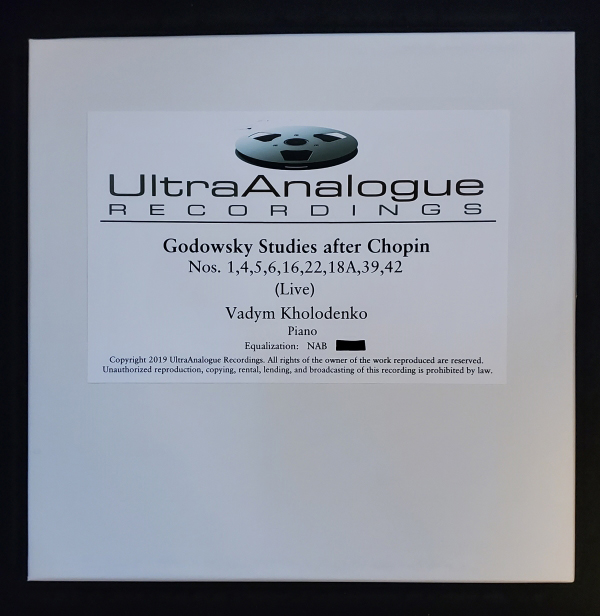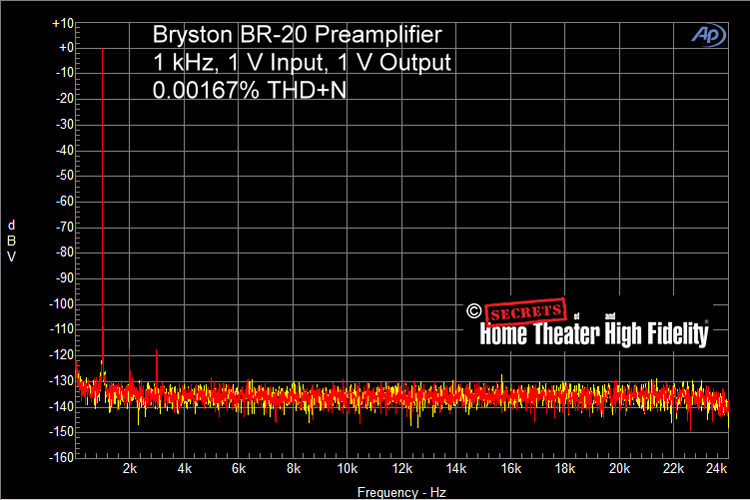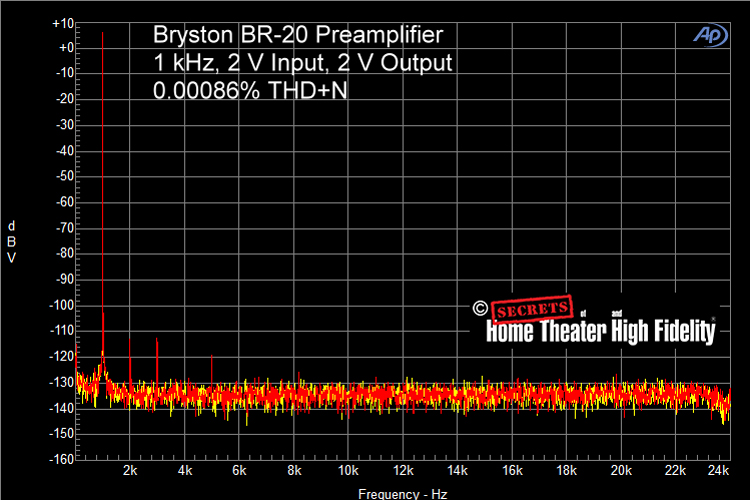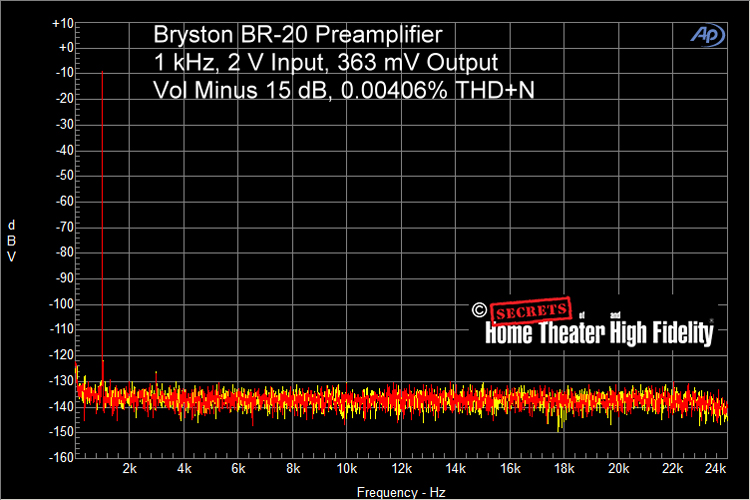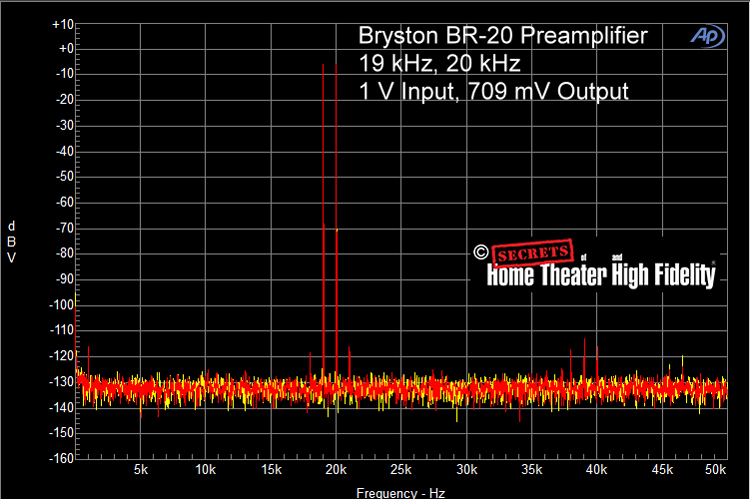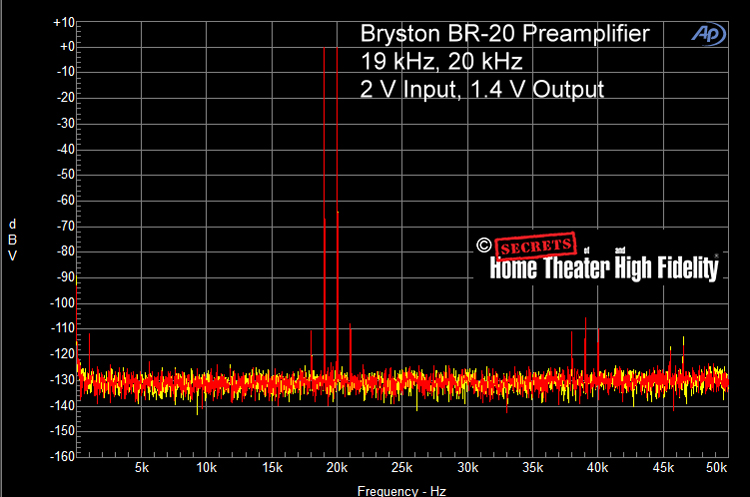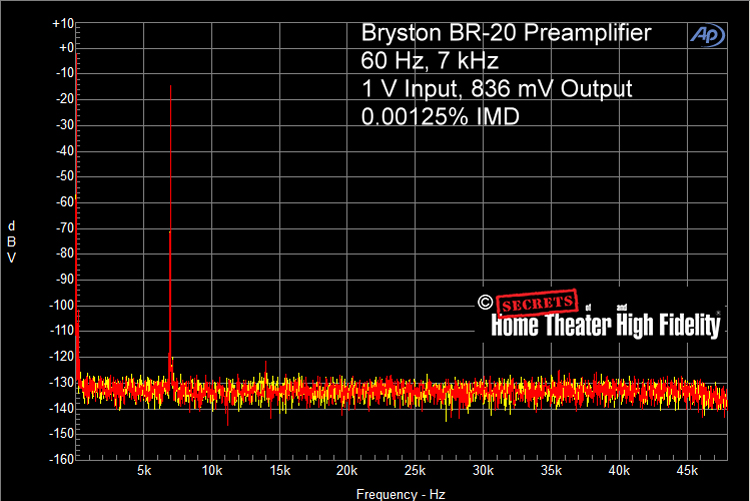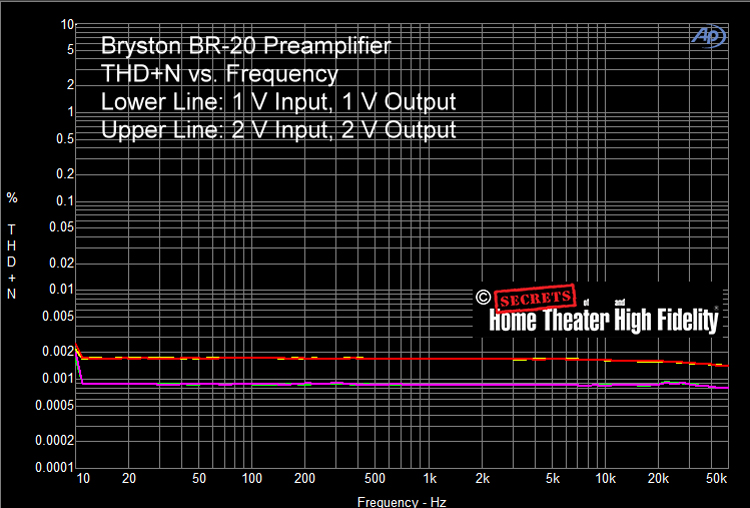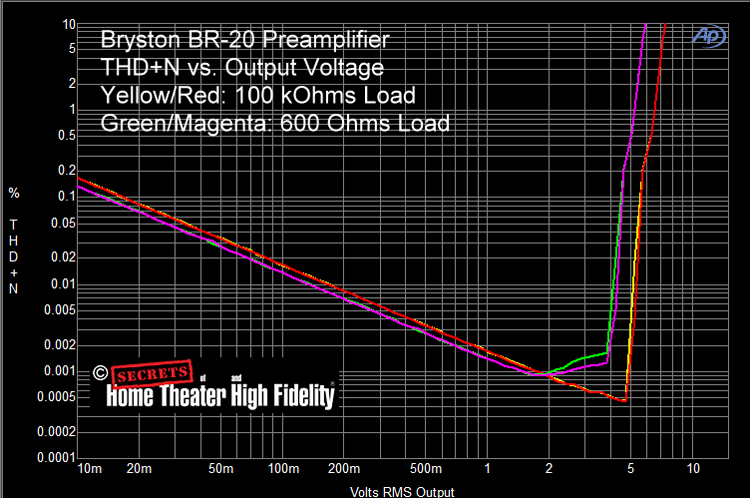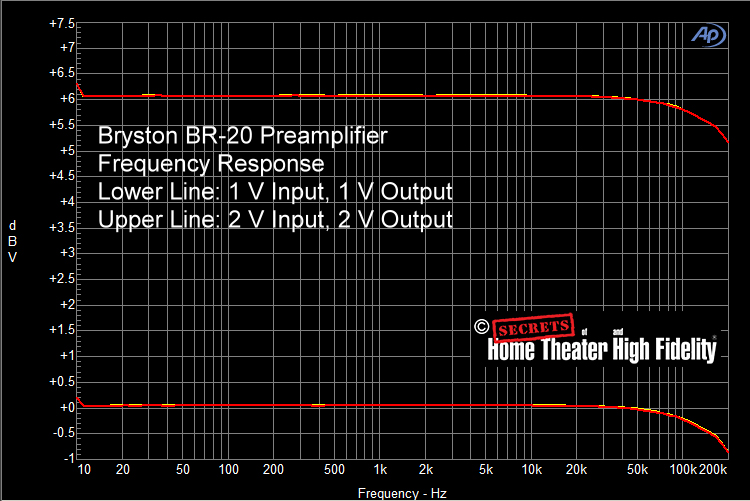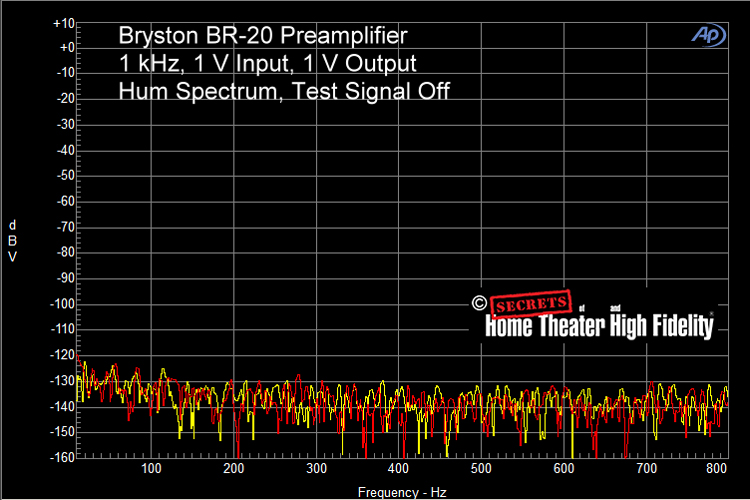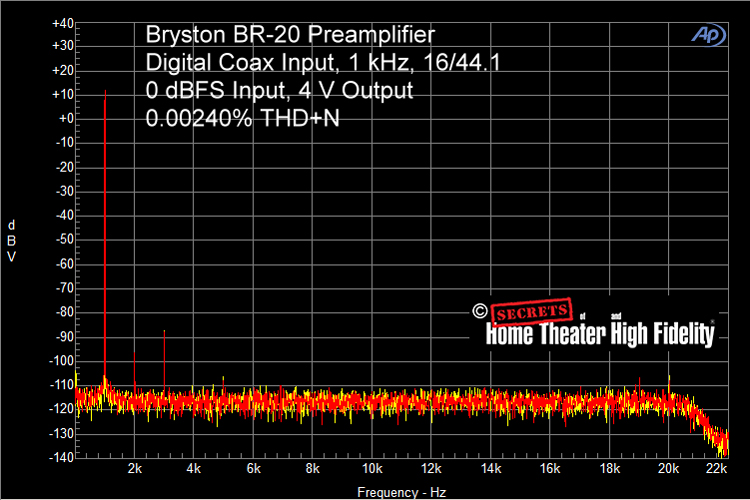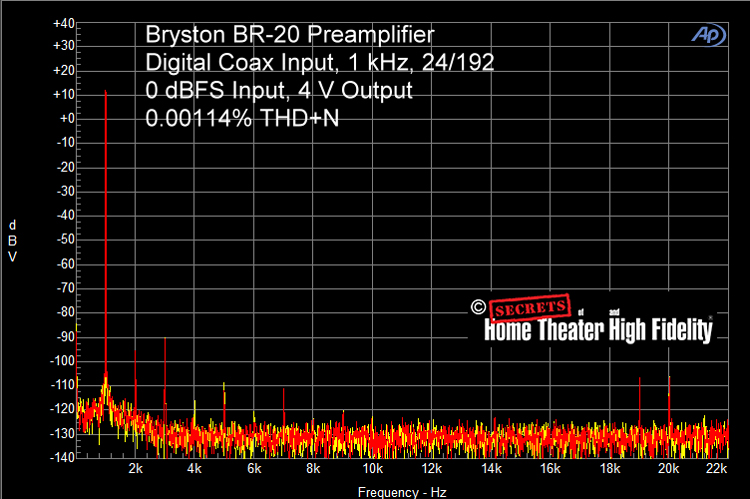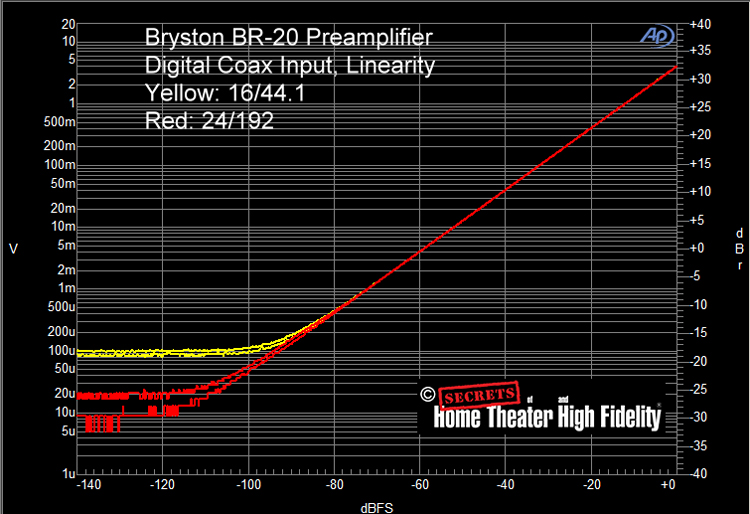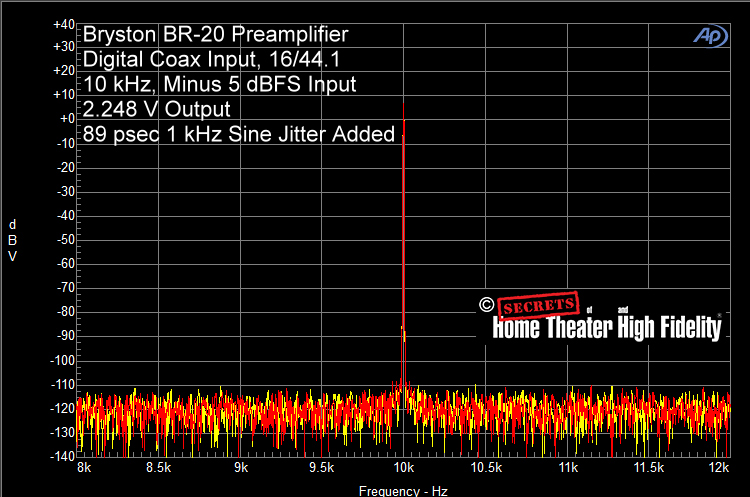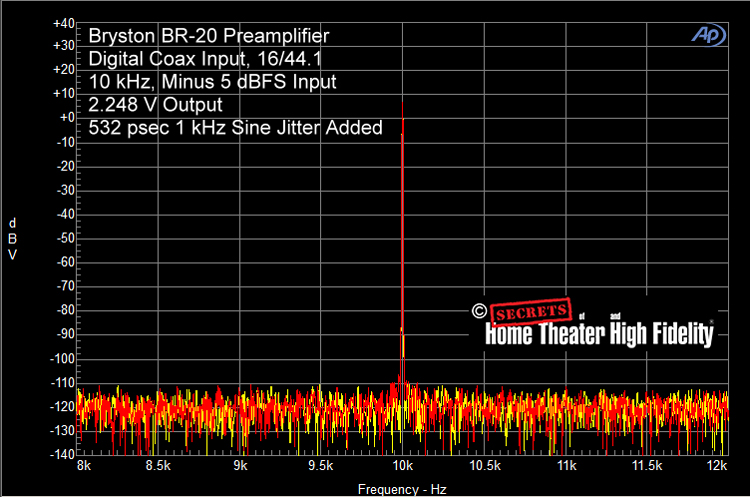More than half a century later, they continue to design and build very high-quality preamplifiers and power amplifiers. They have also branched into DACs and speakers.
The BR-20 Stereo Preamplifier is the latest culmination.
Bryston BR-20 Stereo Preamplifier
- Balanced and Single-Ended Inputs
- Balanced Outputs
- Pure Class A analog circuitry
- Independent power supply for analog and digital circuits.
- Relay switching on all inputs
- DAC decodes up to PCM 32/384 and DSD-256
- Digital Inputs include AES/EBU, TOSLINK, S/PDIF (RCA Coax), and USB
- High-resolution streamer plays back virtually any file format at native resolution.
- Control entire system using intuitive WebUI on a smartphone, tablet, or computer.
- Headphone amplifier
- Optional Internal 4 input, 1 output HDMI card is 4K HDR compatible. Can also receive DSD over HDMI
- Optional MM Phono Stage (replaces 1 RCA analog input)
Bryston’s latest entry into the world of high-end audio preamplifiers is the BR-20. Having designed such products since 1962, they bring a lot of experience into this item, and it shows.
Frequency Response:
20 Hz – 20 kHz ± 0.05 dB
S/N Ratio:
XLR Minus 110 dBR
RCA Minus 110 dBR
IMD:
≤ 0.0003%
THD+N:
≤ 0.0006% 20 Hz – 20 kHz
Dimensions:
17” W x 4.6” H x 13” D
Weight:
12 Pounds
MSRP:
$5,995.00 US
Finishes:
Silver or Black
Website:
Company:
SECRETS Tags:
bryston, preamplifier, br-20, hi-fi
The Bryston BR-20 checks in at a very light 12 pounds. The reason for this is that it only has two gain stages. That is good, and it is not easy to do. The total gain is 12 dB. For the DAC, two 32-bit AKM 4490EQ chips are utilized.
The front panel is more complex than most preamps these days, with buttons for every input as well as balance, mute, and power on/off.
There is an LED panel that shows the volume and input name that has been selected since the input buttons are simply named SRC-1 through SRC-10.
The digital sample rate is also displayed on small LED lights at the top of the panel. The DAC accepts up to 32/384 PCM and DSD512.
The rear panel is shown below. Most of the stereo pair inputs and outputs are XLR balanced, so I think Bryston is obviously suggesting you utilize XLR which lowers noise and distortion.
The DAC accepts Coax (RCA), AES (XLR), SPDIF (RCA), and USB. An optional HDMI card allows access to four HDMI inputs and one HDMI output at the top of the panel.
Access is provided by Ethernet, USB, and R-232 jacks.
The AC input is three-pronged grounded. There are also Trigger-In and Trigger-Out jacks.
A remote control is provided, and you can also download an app for your phone to control the BR-20.
You can stream music to the BR-20 from many streaming services using the Streaming Ethernet input. If you have a lot of components connected to your wireless network, you can just use a laptop that has the streaming app on it for selecting albums to play and use the USB digital output from the laptop with a USB cable that has a USB-B connector to fit into the USB Digital Audio input on the BR-20 rear panel.
For this review, I utilized a VPI HRX turntable, Sumiko Starling phono cartridge, Pass Labs XP-27 Phono Preamplifier Otari MX-5050B-III-2 Reel-to-Reel Tape Deck, Sennheiser HD 660 Headphones, OPPO BDP-105 Disc Player, Parasound JC 1+ Monoblock Power Amplifiers, and Sonus faber Lilium Speakers. Also in use were Clarus Crimson Audio Cables, and a Clarus Concerto Power Conditioner with Crimson Power Cable.
Complete List of Reference Components: OPPO BDP-105 Universal Player (4), OPPO UDP-205 Universal Player (2), VPI-HR-X Turntable with Sumiko Starling and Palos Santos MC Cartridges, Otari MX-5050B-III-2 Reel-to-Reel Tape Deck, AURALiC ALTAIR G1 Digital Audio Streamer, Manley Labs Steelhead Tube Phono Preamplifier (2), Balanced Audio Technology VK-5i Pure Class A Triode (Tube) Stereo Preamplifier (2) (Fully Balanced), Balanced Audio Technology VK-500 Solid State Stereo Power Amplifier (Fully Balanced) (250 Watts per Channel), Pass Labs Xs Stereo Preamplifier, Pass Labs XP-20 Stereo Preamplifier, Pass Labs XP-27 Phono Preamplifier, Pass Labs Xs 300 Monoblock Pure Class A Power Amplifiers (2) (300 Watts/each), Parasound JC 1+ Monoblock Power Amplifiers (2), Lamm LL1 Signature Stereo Pure Class A Triode (Tube) Preamplifier, MartinLogan CLX Full-Range Electrostatic Speakers (2), Sonus faber Lilium Speakers (2), Paradigm Reference Signature SUB 2 Subwoofers (2), Custom-Built Computer for Audio Analysis, Accupel HDG-3000 Digital Color Signal Generator (1080i capable), Component Video and DVI Output, ColorFacts Pro Video Test and Calibration Software, Version 6.0, Spyder Sensor, SpectraPlus Audio Analysis Software, Audio Precision SYS-2722 Spectrum Analyzer, Staco 3PN2210B-DVM 22 Ampere Variable Transformer (for adjusting line voltage to 120 volts during amplifier power output tests), Classé SSP-800 Surround Sound Processor, Emotiva XMC-1 Surround Sound Processor, Classé CA-5200 Five-Channel Power Amplifier (200 Watts per Channel), Pass Labs X600.8 Power Amplifiers (4) (600 Watts/Each), Audio Control Phase Coupled Activator (Sub-Harmonic Generator), Carver Platinum Mark IV Ribbon Speakers (2), MartinLogan Summit X Hybrid Electrostatic Speakers (2) (Rear Left/Right), MartinLogan Stage X Hybrid Electrostatic Speakers (3) (Center and Sides Left/Right), MartinLogan Balanced Force 212 Subwoofer, Velodyne DD-18+ Subwoofer (3), HiFiMAN HE1000 Planar Magnetic Headphones, OPPO PM-1 Planar Magnetic Headphones, Sennheiser HD 660S Headphones, OPPO HA-1 Headphone Amplifier, Bryston BUC-1 USB Converter, Sony VPL-HW55ES 1,920 x 1,080p Digital Projector, 90″ (Diagonal) Stewart Grayhawk Projection Screen, Sony 75″ UHD (4K) Flat Panel Display, Clarus Audio Cables, Clarus Concerto Power Conditioner with Crimson Power Cable.
Instrumental Classical Guitar – Various Artists – Boy and Guitar Media – Released April 2021 – Streamed
I usually listen to some guitar music when reviewing products (and when I am just listening, period). This instrument has leading-edge transients that can be harsh if there is harmonic distortion.
From this album, “Oremus in D Minor” by Andrea Vettoretti and “Estudio de uno Nota” by Sergio Fabian Lavia are good choices. Very strong plucking. It was clear, detailed, and smooth (free from harsh transients).
In fact, in Estudio, the guitarist (Lavia) alternates between soft and hard plucking. So, you would be able to hear if the hard plucks were edgier (harsh) than the soft ones.
The entire album is excellent but not all of them are relaxing. Good, you can click the “Next” button on your phone or pad from time to time.
Enya – Watermark – Warner Records – Released May 2005 – Streamed
I am not generally a fan of computer-generated music, but Enya is an exception, and this album is a classic.
The first track, “Watermark”, is the same as the album title. Even if you are not an Enya fan, you will recognize it from when it was played so often back in 2005.
Computer-generated sounds can often be edgy due to the way they are generated. There is no microphone in the path which might soften them.
So, if the sound system has significant distortion, they can sound uncomfortably harsh. Not so with the BR-20. Even my cats liked this album. They are always in the music room when the albums sound sweet and soft. Their ears are very sensitive. I remember one time my cat Buttons got up and left the room way back in the day when I tested 10 kHz sine waves through speakers. She didn’t like it at all. I blew out the tweeters and had to replace them. I don’t run those kinds of tests anymore.
Secrets Sponsor
With “On Your Shore”, Enya sings, and her voice is like a dose of ®Valium. The other voices and instruments are obviously digitally synthesized.
Art Pepper – Art Pepper Meets the Rhythm Section – Contemporary Stereo – Released in 1957 – Vinyl
I did not have the optional phono preamplifier card installed on the BR-20, and it would not have made a difference anyway because my phono cartridges are all MC (Moving Coil), and the BR-20 phono preamp card is MM (Moving Magnet).
If you have read my reviews, you know this album is a go-to for me. I have it in several versions, including vinyl, CD, and DSD.
I used the vinyl version here, and it was smooth and silky, suggesting again that the BR-20 has very low distortion, perhaps inaudible. There is a bit of background noise with all vinyl, so this album would not be a good test for noise. But, with the other recordings (digital) I listened to, I could not hear any background hiss, so I suspected that the BR-20 is a very low noise component. Read the On the Bench section to see what I found.
Stan Getz & Bill Evans – Verve Re-issue – 1973 – CD
This album shows why classical jazz (the 1950s–1970s) was so different from the jazz of today. The songs of yore had actual melodies. Of course, there were classical songs of yore that were available, like “Night and Day” and “But Beautiful”. The album was originally recorded in 1964, with drummer Elvin Jones and either Richard Davis or Ron Carter on bass (Getz on tenor sax and Evans on piano).
It really does not get any better than this. The render of “Melinda” is absolutely incredible.
An image of guys and gals dancing close and whispering to each other. Wow!
Available for 7 bucks on Amazon. If you like classical jazz, this is a must-have album if you don’t already own it.
Godowsky Studies after Chopin Nos.1, 4, 5, 6, 16, 22, 18A, 39, 42 – Vadym Kholodenko on piano – UltraAnalogue Recordings – 10.5” RTR Tape, 15 IPS, NAB EQ – Released in 2019
The Godowsky Studies are transcriptions of Chopin Études and Godowsky’s purpose was to make these even harder to play than they already are. They are the ultimate test of the left hand, as he’s reversed the roles of each hand, with the melody being played mostly by the left hand. Occasionally, the entire étude is played only with the left hand.
I watched a video of the playing, and Vadym Kholodenko, indeed, was playing an étude only with the left hand. This tape was recorded by UltraAnalogue Recordings in 2019. It is a modern tape, not something from the past century. It is analog all the way. No digital intermediate.
Piano is a great test for an audio component because so many notes can be played at the same time, so if there is a lot of intermodulation distortion, the sound would be congested. Not so with the BR-20. No congestion at all. So, I guessed that the BR-20 would bench test at very low IM. See below. I listened first through the headphone jack on my Otari MX-5050B-III-2 tape deck and then through the headphone jack on the BR-20, and also with the complete system (deck, BR-20, power amplifiers, and speakers).
For the analog tests, I utilized the XLR balanced inputs. The XLR balanced outputs were used for all the tests. Except where noted, the volume control was set at 0.0 dB. The yellow trace is the left channel, and the red trace is the right channel, except in a couple of cases.
Let’s start out with the analog tests. First, 1 kHz at 1 Volt. Distortion was 0.00167%.
At 2 Volts output, THD+N was lower, at 0.00086% even though the distortion peaks were a bit higher. This is because the noise floor remains the same while the test frequency peak is higher, so the percentage distortion plus noise is lower. The result is in the range of the BR-20 spec. In any case, the distortion and noise are inaudible.
Here is a test result with a typical input of 2 Volts that would occur with a disc player output. I turned the volume control to -15 dB to produce a reasonable output to feed the power amplifiers for a typical listening level. THD+N was 0.00406%. The distortion peaks were at about -125 dB and the noise floor at about -135 dB. You will only hear the music with a clean detailed sound. No audible distortion or noise.
Moving on to the 19 kHz, 20 kHz tests, at 1 Volt output, there is only one side peak on either side of the two test signal peaks, with a few peaks up around 39 kHz which are not within the range of hearing. So, at a typical listening level, there is not much IM at all.
At 1.4 Volts output, which would be pretty loud, there is still only one noticeable side peak at 18 kHz and 21 kHz, and they are -110 dB. Not audible.
The standard IM tests of 60 Hz and 7 kHz sine waves are shown below. First, 1 Volt input, 836 mV output. IM was a very low 0.00125%.
At 1.67 Volts output, 0.00080% IM. This is a really fine test result and is why the music I listened to did not have any congestion.
Shown below is THD+N vs. Frequency, 1 Volt output is the upper line, and 2 Volts output is the lower line. Again, the higher output is associated with a lower distortion plus noise because the noise floor does not change. In both cases, the reading is in the 0.001% and 0.002% throughout the audible range. Excellent!
THD+N vs. Output voltage is shown below. It slopes downward due to the noise floor remaining the same, so the percentage distortion plus noise decreases. For a 100 kOhm load, this decrease occurs until 4.7 Volts output where it is 0.00048%. Then it goes up and clips (1% THD+N) at 6.5 Volts output. Using a 600 Ohm load changes the direction at 2 Volts output, with clipping at 5.2 Volts output. A 600 Ohm load is just a stress test to see how strong the power supply is. It would never be an actual load for any power amplifier. These results indicate a reasonably strong power supply. Not the strongest I have seen, but perfectly satisfactory.
The analog frequency response is flat out to 20 kHz and then slowly decreases 0.02 dB at 50 kHz. It is down only 0.03 dB at 100 Hz.
Here are two hum spectra, the first with the 1 kHz test signal on. Hum is below -120 dB.
With the test signal off, hum drops a couple of dB. This represents very good shielding.
Now, we move on to the BR-20 DAC.
First, 1 kHz, but instead of inputting a specific voltage, such as 1 Volt, we use dBFS which means dB Full scale. So, at 0 dBFS, the input is the maximum digital value and that results in the maximum output voltage from the DAC’s analog output stage. In this case, it is 4 Volts. Sampling was 16/44.1. THD+N was 0.00240%. The 2nd, 3rd, and 5th harmonics are visible.
With 24/192 sampling, THD+N was 0.00114%. Other harmonics are visible because the4 noise floor is much lower.
Linearity measurements are shown below. With 16/44.1 sampling, the curve is linear to about -100 dBR, and with 24/192 sampling, it is linear to about -120 dBR. It is an illustration that with higher sampling rates, more low-level detail in the music will be apparent.
Here are the Frequency Response measurements for the three PCM sampling rates. For 16/44.1, the high-end response is down 0.2 dB at 20 kHz, which means the response would be defined as 20 Hz – 20 kHz ± 0.1 dB. It is down 0.6 dB at 30 kHz for both 24/96 and 24/192 sampling, which is a reflection of the analog output stage limitations.
Let’s now check out the jitter rejection. First, at 16/44.1. Adding 89 psec of sine jitter to the 10 kHz sine wave input signal showed no jitter peaks at 9 kHz or 11 kHz.
Increasing the sine jitter to 532 psec also resulted in no jitter peaks. At this point, I knew the BR-20 had a re-clocking circuit in the DAC. I confirmed this with Bryston.
Now, at 24/192. First, with 81.4 psec of 1 kHz sine jitter added. No jitter peaks.
And, with 529 psec jitter added, no peaks either.
The BRYSTON BR-20 STEREO PREAMPLIFIER is a terrific addition to the Bryston lineup of analog products.
- Short signal path
- Very high-quality parts
- Low distortion and noise
- Re-clocking circuit in DAC
- Input names on front panel (rather than SRC)
- Selected input on LED panel shown constantly
- MC phono cartridge capability In phono preamplifier
Distortion and noise are remarkably low, a testimony to the high quality of parts that are available now, and to the engineering skill at Bryston necessary to implement them. The DAC has re-clocking, which is very important when streaming audio from USB digital outputs on computers, and it is capable of decoding the highest level of PCM and DSD sampling formats.
Secrets Sponsor
The sound is neutral. It does not add a “voicing” of its own. It does not change the tonality. It gets us closer to the “straight wire with gain” philosophy that many audiophiles search for. As Forrest Gump said, “That’s one less thing,” when he opened his mailbox to find a financial statement about the fortune he had made with stock in the new company, Apple, that Lt. Dan had purchased for him. In other words, that is one less thing to worry about in the signal path.


